John Hurrell – 27 March, 2016
The combination of Bollywood visages with Auckland coastline vistas means that if these paintings were shown in an Indian city, Aotearoa would acquire an exoticism as a potential film site. However shown in Titirangi as they are, that meaning is not apparent - for the sites are too geographically close to the gallery. (If they were Otago or Southland landscapes the readings might be different.)
Auckland
Bepen Bhana
Frankie goes to Bollywood
13 February - 15 May 2016
With these eight diptyches Bepen Bhana continues a theme he has been exploring for several years now with paintings and hoardings, that of romantic heterosexual love and landscape backdrops, only now they are more panoramic (ie. longer horizontally) and overtly referencing of the film (especially Bollywood film) industry - using stars and promotional billboard proportions. And with the carefully chosen actors and actresses (as glamorous ‘couples’) we have West Auckland coastal scenes and lush green vegetation, hot burnt sienna rock faces, and saturated blue skies. They are more visually ‘excessive’ than his earlier more natural permutations.
The gorgeous couples in a sense are in competition with their seductive backdrops. The paintings are imposing in size with their wide vistas, and the stars are not only handsome but also pale skinned, not because of any identificatory emulation of Caucasian culture outside of India (a possible theory), but because the disproportionately influential Brahmin caste is usually paler, and fair skins are regarded as more attractive than dark.
The combination of Bollywood visages with Auckland coastline vistas means that if these paintings were shown in an Indian city, Aotearoa would acquire an exoticism as a potential film site. However shown in Titirangi as they are, that meaning is not apparent - for the sites are too geographically close to the gallery. (If they were Otago or Southland landscapes the readings might be different.) However the bringing of Bollywood to West Auckland intrigues in a different sense because it is an inflection on the notion of ‘home’, that space now seeming to be validated by images from afar. The geographic mingling superficially puts an ‘Indian’ stamp on these beaches.
As painted statements it is tempting to wonder what the two sorts of component would be like separated in isolation, because their synthesis is uneasy. We don’t see the couples actually standing on the earth of each site, only heads, shoulders and torsos in front of the ‘artificially’ positioned backdrops. And the landscapes do dominate. It could be argued that as spectacle they upstage the attractiveness of the celebrity actors.
Of course I’m only speaking for myself here, as someone familiar with the painting of say Canterbury painter William Sutton (famous for his large panoramas of the Port Hills) and ignorant of the nuances of Bollywood, but an Auckland Indian audience could read these images very differently, recognising the actors immediately and remembering various productions they have been involved with, the narratives involved, and not being remotely interested in regionalist landscape painting traditions.
Bepen Bhana obviously knows this. His titles, avoiding English translations but using Hindi and Te Reo, swing the focus towards Hindi and Maori audiences who will be aware of the context of the personalities, or the pre-European landscapes devoid of western architecture - and so the work doesn’t mingle the two cultural perspectives. His overlaying is openly based on collage so that the actors remain like cut-out stage props - chimeras that dissolve in the overwhelming presence of the land.
John Hurrell





 Two Rooms presents a program of residencies and projects
Two Rooms presents a program of residencies and projects Advertising in this column
Advertising in this column



This Discussion has 0 comments.
Comment
Participate
Register to Participate.
Sign in
Sign in to an existing account.